|
Devonian
White Chertized Fossils
From
White Coral Ridge
Expedition:
8/2010
|
|
Updated 9/1/10

|
Introduction:
Here are the results
of two collecting expeditions to a fossil locality in the Late
Frasnian Devonian Martin Formation north of Payson. This locality
which was found along Houston Mesa Road at the very top of a
non descript hill has some of the most unique fauna we have ever
found in the Martin. Preservation is in a ceramic like white
chert, and fossils are scattered across a wide area being concentrated
on the top of the hill due to erosion out of the limestone matrix.
Found at this unique locality also were large section of crinoid
stems- totally unlike most Martin localities we have visited,
urchin spines - extremely rare in this formation, and finally
hordes of geodes and quartz crystals. Some trace fossils were
found in one broken block of material, something we dont often
see in the martin is larger sized burrows. All said, this site
is a real treasure, one of the sites we will be going back to
again and again for new exciting finds!
|
Click on Thumbnails for 1024 x 768 size
Coelentrates - Rugose Corals
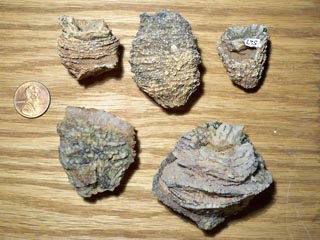 | Solitary
Rugose Corals - these range in morphology from barrel shaped
at top to like a broad stack of funnels such as the large specimen
at the bottom. This one is complete, with root base attachment
point still intact. Corals are identified mostly on cross section
details by sawing the specimen up into slabs and examining the
septal details. Lets just say Im not ready to do this quite yet! |
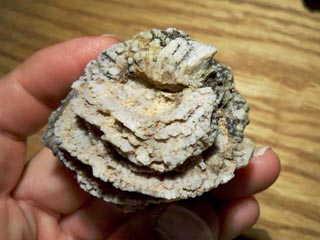 | Large
magnificent specimen unlike anything we have ever encountered
in the Martin. |
Echinoids - Urchins
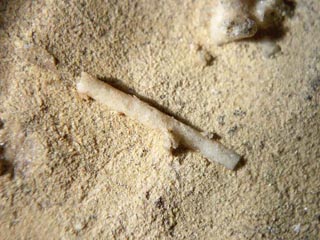 | Isolated
small spine, some half inch long. Smooth exterior, with ends
missing. This would have been from a sea urchin around an inch
in diameter. |
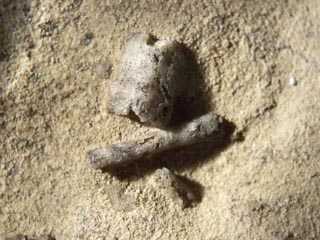 | Another
isolated spine, and a crinoid columnal. |
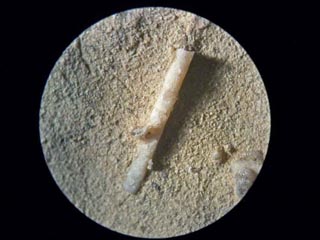 | Microscopic
examination of urchin spine. |
Enchinoderms
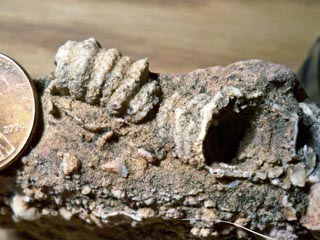 | Large
half inch diameter crinoid stems. Many of them were long unbroken
pieces up to several inches long. Most crinoid material - IF
we find any at all in the Martin - are faint impressions in the
limestones. These are amazing. |
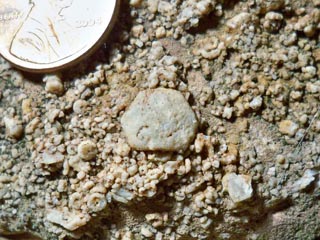 | Interradial
Plate, the bottom of the calyx would have been at the top in
this orientation. Were looking at crinoids that are golf ball
sized on top of long robust stems. |
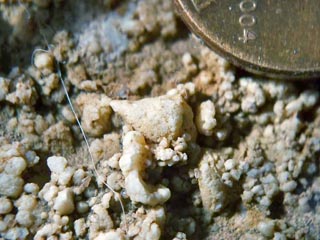 | Crinoid
armor spike. These circled the calyx and protected the crinoid
from large fish and predators. |
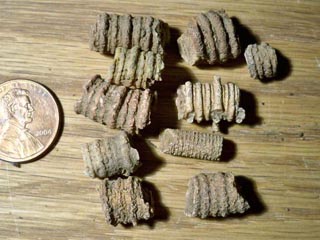 | Collection
of stems from the top of the hill, while it was pouring rain.
The smaller stems with narrower ridges were nearer to the top.
(The stems were tapered) |
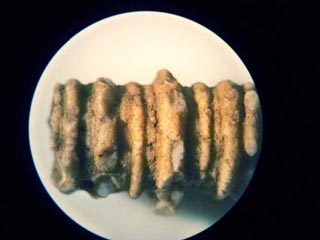 | Microscopic
view of stem section. The larger ring in the middle is a nodal,
and is where the cirii were attached. these feeler like appendages
allowed the crinoid to attach to near by objects and keep their
distance from other crinoids. |
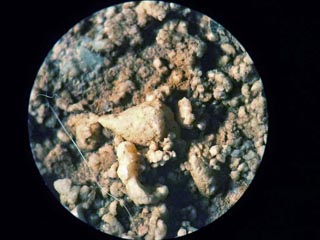 | Microscopic
view of armor spike. Think of the crinoids calyx as a mace club
with big spikes all over it. Except with crinoids, the spikes
were on a band that circled the "equator" of the cup.
We find a ton of these in the Naco on a very primitive crinoid
type. Perhaps these are an earlier version.? |
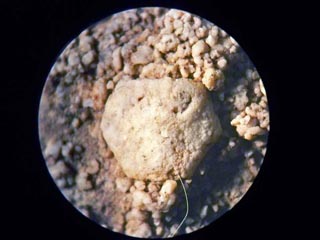 | Microscopic
view of interradial plate. |
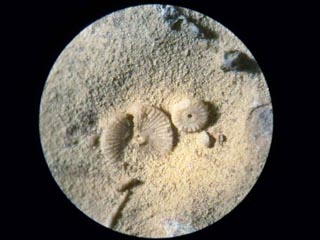 | Microscopic
view of columnals (ossicles or stem segments). If you split a
stem, this is what you get. |
Brachiopods
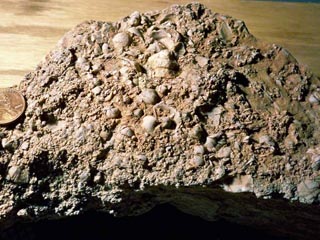 | Superb
block of limestone with hundreds of brachiopods was a prize find. |
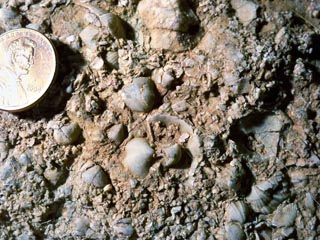 | Close
up of slab shows spirifer and rhynconellids, with some crinoid
material. |
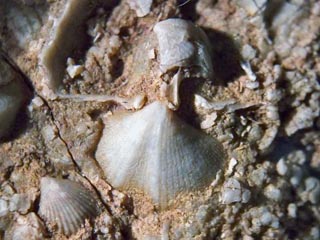 | Cyrtospirifer
sp. - Top part of valve exposed, with Cupularostrum sp. to the
lower left. |
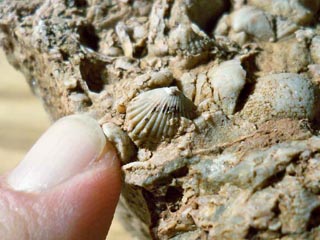 | Cupularostrum
sp. - a Rhynconellid Brach |
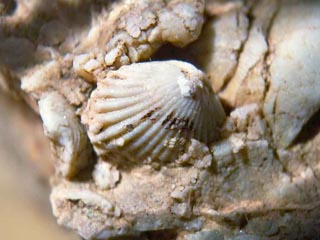 | Cupularostrum
sp. - a Rhynconellid Brach, closer view. |
Quartz Crystals and Geodes
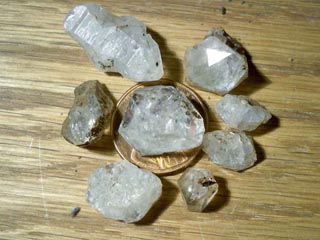 | Dawn
found quite a handful of half inch sized quartz crystals here.
Many Martin limestone sites have a few along with the fossils,
they seem to grow right in the matrix. The source of the silica
for these could very well be the glass sponges that were very
common at this time on the sea bottom. |
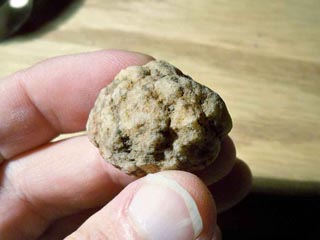 | Quartz
geode, or "brain stone". These were found in extreme
abundance at this site, and range in size from half an inch to
about 4 inches. They are psudomorphs, calcedony quartz after
some sort of evaporite nodule, maybe Howlite. When these are
found, no fossils except trace fossils are found. The sea water
was too salty as it evaporated on a shallow flat area. |
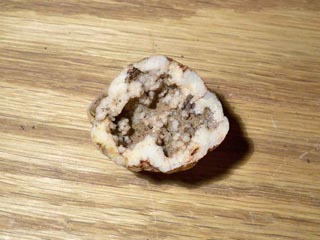 | Inside
most geodes are quartz crystals or they are solid white calcedony
throughout. |
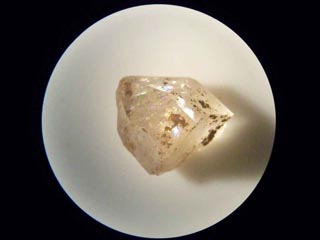 | Microscope
close up of quartz crystal, a particularly fine one for facets. |
Trace Fossils
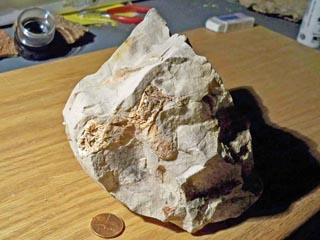 | Thallassanoides
- Shrimp burrows. The typical "Y" shaped burrows were
from a type of callanassid shrimp that occupied tidal flats.
Perhaps this is why we found them near the geodes. |
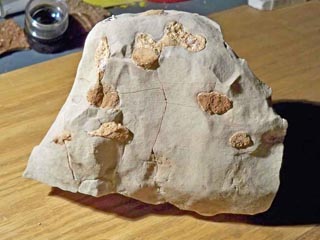 | The
other side of the above specimen. |
|

Paleo
HOME
|